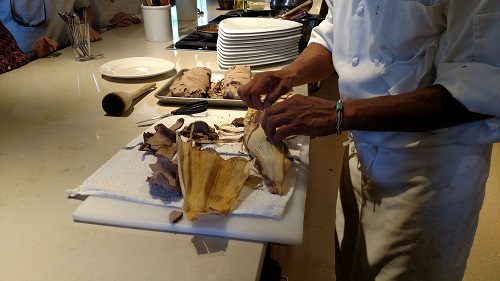Trout with Fresh Herbs Wrapped in Corn Husks and Baked in Clay

Trout with Fresh Herbs Wrapped in Corn Husks and Baked in Clay
This is a series of 4 recipes from the lunch I had last month at the Santa Fe School of Cooking. The menu was done by Lois Ellen Frank and Walter Whitewater. The food was just incredible! These recipes are published with Lois's permission.
Please scroll down the pages on our Blog to see all 4 recipes:
Please enjoy! © By Lois Ellen Frank, Ph.D.  Southwestern Peoples have worked with clay for thousands and thousands of years. Using the archaeological record of the past, it is known that plain wares were first made millennia ago.
Southwestern Peoples have worked with clay for thousands and thousands of years. Using the archaeological record of the past, it is known that plain wares were first made millennia ago.
Clay is found in beds that are formed from the physical and chemical alteration of minerals usually found in igneous rocks such as granite. Some of the most extensive clay sources in the Southwest are uplifted beds that were once marine deposits. More than one kind of clay is available in almost every part of the Southwest, and only experience in the selections of materials yields a desired product. Pottery has been a part of life in the Southwest for generations and pottery artistry has received much attention as both objects of beauty and of study.
According to Native potters today, working with clay has always been an act of creation and a part of Native life. This recipe utilizes the use of New Mexican clay that is molded around fresh trout. The trout is stuffed with fresh herbs, wrapped in moistened corn husks and then it is baked in an oven. 
But Walter Whitewater, a traditional Navajo and contemporary chef, remembers stories he was told of food being baked in clay in open fires until the clay split open and the food was then eaten. He recommends that you prepare trout this way before going on a camping trip and then placing it in the embers of your camp fire and cooking it until the clay dries and then cracks open. The clay keeps the trout moist and seals in the flavor of the herbs and bacon. It is one of the best, baked fish dishes, I have ever eaten.
Check in your area to see what types of clay are available that are non-toxic and safe to cook with.
Ingredients:
6 whole fresh trout
12 large sprigs of fresh thyme
12 whole sage leaves
12 green onions, grilled
1 1/2 teaspoons salt
1 1/2 teaspoons black pepper
8 pounds terracotta non-toxic clay (1 1/2 pounds per trout)
12-16 dried corn husks
Directions:
Soak the corn husks in warm water for approximately 10 minutes until pliable. Remove from the water and set aside.
Divide the clay into six equal size portions.
Take one portion of the clay and with a rolling pin, roll out the clay like a dough approximately 1/4-inch thick.
Make sure it is the length of the trout plus 1-inch to ensure that the trout will fit into the clay covering. 
Stuff 2 sprigs of the thyme and 2 sage leaves inside each trout.
Place the grilled green onions on top of the herbs.
Using 1/2 teaspoon each of salt and black pepper, salt and pepper the inside and exterior of each trout.
Place the corn husks with the narrow side out, or lengthwise, and completely wrap them around each trout.
Overlap the corn husks so that no part of the trout is exposed.
You will need approximately 2 to 3 corn husks per trout depending on their size. 
The purpose of the corn husks is to cover the trout completely with the corn husks so that the fish does not stick to the clay.
Cut the clay in half lengthwise with a knife.
Place the wrapped trout on top of one of the pieces of clay.
Cover with the second piece of clay and seal the edges with your fingers, by pressing down around the outer edges.
Make 3 air vents (small slits) with a knife on the top of each clay-covered trout. 
Preheat the oven to 500 degrees F.
Place the clay-covered trout on a baking sheet and bake them for 20 to 30 minutes or until the clay is completely dry depending on your oven and the altitude.
Remove from the oven and let cool. When the clay- covered trout is cool enough to handle, crack is open with a kitchen mallet or press down near the air vent slits with your hands.
The clay will peel off the fish with ease and can then be discarded.
Serve the whole trout immediately. 

 Serves 6
Serves 6
Original recipe “Used with Permission. Excerpted from Foods of the Southwest Indian Nations, Published by Ten Speed Press, © By Lois Ellen Frank” pg 179. © By Lois Ellen Frank














